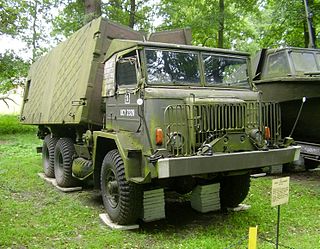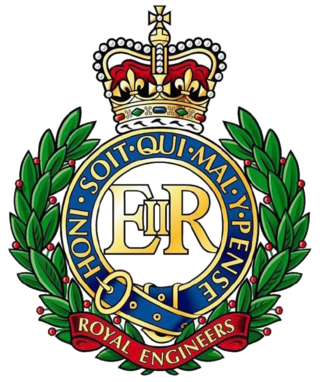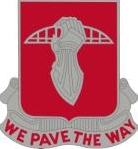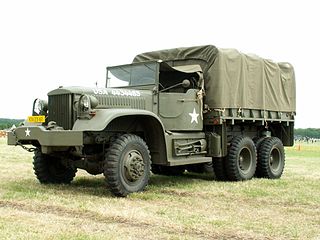
The Mulberry harbours were two temporary portable harbours developed by the British Admiralty and War Office during the Second World War to facilitate the rapid offloading of cargo onto beaches during the Allied invasion of Normandy in June 1944. They were designed in 1942 then built in under a year in great secrecy; within hours of the Allies creating beachheads after D-Day, sections of the two prefabricated harbours were towed across the English Channel from southern England and placed in position off Omaha Beach and Gold Beach, along with old ships to be sunk as breakwaters.

A pontoon bridge, also known as a floating bridge, uses floats or shallow-draft boats to support a continuous deck for pedestrian and vehicle travel. The buoyancy of the supports limits the maximum load that they can carry.
M71, M-71, or M.71 may refer to:

The EFA or Engin de Franchissement de l'Avant is a field-deployable river crossing vehicle, used by combat engineers in the French Army. Unlike a bridge layer, which transports a bridge that is deployed off of the host vehicle, the EFA itself is a combined pontoon bridge and amphibious vehicle, enabling much more rapid redeployment of the mobile bridge structure and an additional use as a ferry. When needed, multiple EFA's can be combined in a series to create a traditional pontoon bridge. It has been built since 1989 by Chaudronnerie et Forges d'Alsace (CEFA), located in Soultz-sous-Forêts in the Bas-Rhin.

NORA M-84 is a Yugoslav and Serbian 152 mm and 155 mm gun-howitzer developed by the Military Technical Institute (MTI) for the Yugoslav People's Army, Serbian Army, and export. Gun howitzer NORA has three basic versions, and is usually towed by a FAP 2026 BS/AV truck.

The M-77 Oganj is a 128mm self-propelled multiple rocket launcher developed in the former Yugoslavia. Its NATO designation is YMRL-32.

FAP 2026 is a general purpose off-road lorry made by Serbian vehicle manufacturer Fabrika automobila Priboj (FAP). The six-wheel drive lorry is designed for transport of personnel, weapons and material up to 6 t of total weight, as for traction of weapons and trailer up to 7.2 t of weight for the needs of the Yugoslav People's Army.

The PP-64 Wstęga is a Polish military pontoon bridge produced since 1966. The design, based on the Soviet PMP model, commenced in 1964. The prototype was tested in 1965. Unlike PMP, rated for 60,000 kilogram load, PP-64 was rated for 40,000 kilograms, still sufficient to carry T-54/55 and T-62 main battle tanks of its period. Jane's Military Vehicles and Logistics staff supposed that PP-64 may also be capable of supporting T-64 and T-72 tanks.

The PMP Floating Bridge is a type of mobile pontoon bridge designed by the Soviet Union after World War II. The bridge's design enables for a quick assembly of its parts. It has a carrying capacity of 60 tons. The bridge was originally mounted on a KrAZ-214, but later transferred to a KrAZ-255. During the process of its deployment, a truck carrying the bridge is backed alongside the edge of a body of water. The bridge is then rolled off where it unfolds automatically. The bridge spans 382 metres, load capacity 20 tons, or 227 m, load capacity 60 tons, with 32 river pontoons, 12 bridging boats and four shore pontoons.
Operation Whirlwind was a failed Croatian Army (HV) offensive in the Banovina region of Croatia, fought from 11–13 December 1991, during the early stages of the Croatian War of Independence. The offensive employed a single infantry brigade as the main attacking force, supported by a bridging unit and a handful of tanks and armoured personnel carriers. Although the offensive met hardly any resistance in its initial stage, achieving tactical surprise, the operation was poorly planned, supported and executed as a result of limited training and combat experience. The offensive established a short-lived bridgehead, evacuated in panic two days after the operation commenced, under tank and mortar fire from the Yugoslav People's Army (JNA) deployed north of Glina.

This is a list of bridging and trackway equipment used by the Royal Engineers of the British Army. For more equipment in use with the Royal Engineers, see Modern equipment of the British Army.
The Battle of Logorište was fought east of Duga Resa and south of Karlovac, Croatia, from 4–6 November 1991 during the Croatian War of Independence, between the Croatian National Guard and the Yugoslav People's Army. The ZNG placed the JNA-held Logorište barracks under a blockade as part of the countrywide Battle of the Barracks, which aimed to pin down JNA units isolated in their bases and force them to surrender weapons and ammunition to the ZNG. However, the JNA garrison broke out from the besieged barracks with part of its stored equipment before the ZNG claimed the vacant base. The breakout was supported by JNA units and SAO Krajina units deployed to lift the blockade of the barracks and other JNA garrisons in Karlovac. A battle ensued as the ZNG attempted to contain advancing JNA units, ending with a ceasefire signed in The Hague.

The 17th Armored Engineer Battalion was a part of the 2nd Armored Division "Hell on Wheels". During World War II, they were active in North African Campaign, and Western Europe Campaign. 17th Armored Engineer Battalion was founded on 1 October 1933 as part of the US Army. First called 17th Engineer Battalion, Motorized. It was renamed on 10 July 1940 to 17th Engineer Battalion (Armored) and assigned to the 2nd Armored Division. The unit became active and started training 15 July 1940 at Fort Benning, Georgia. Renamed again on 8 January 1942 as the 17th Armored Engineer Battalion. The Battalion is now based at Fort Cavazos, Texas. The battalion's motto was We pave the way. Tasks of the 17 included construction and demolition under combat conditions, constructing and breaching trenches, tank traps and other fortifications, bunker construction, bridge and road construction, and building destruction bridges and other physical work in the battlefield whenever needed. They also laid and cleared land mines. The 17th facilitated the movement and support of friendly forces while slowing down the enemy's forces.

The KrAZ-255 is a Soviet three-axle off-road truck with six-wheel drive, intended for extreme operations. It was manufactured at the KrAZ plant beginning from 1967.

An Engineer Light Ponton Company was a combat engineer company of the United States Army that served with U.S. Army ground forces during World War II. It was primarily a highly mobile pontoon bridge construction unit, though it also provided both M2 assault boats and a selection of infantry support bridging, ferries, and rafts.

The 6-ton 6×6 truck was a family of heavy tactical trucks built for the United States Army during World War II. The basic cargo version was designed to transport a 6- short ton (5,400 kg) cargo load over all terrain in all weather. The chassis were built by Brockway Motor Company, The Corbitt Company, The Four Wheel Drive Auto Company (FWD), Ward LaFrance Truck Corporation, and White Motor Company. They were replaced by the M54 5-ton 6x6 trucks in the 1950s.

The Diamond T 4-ton 6×6 truck was a heavy tactical truck built for the United States Army during World War II. Its G-number was G-509. Cargo models were designed to transport a 4-ton (3,600 kg) load over all terrain in all weather. There were also wrecker, dump, and other models. They were replaced by the M39 series 5-ton 6×6 trucks in the 1950s.

An auxiliary floating drydock is a type of US Navy auxiliary floating dry dock. Floating dry docks are able to submerge underwater and to be placed under a ship in need of repair below the water line. Water is then pumped out of the floating dry dock, raising the ship out of the water. The ship becomes blocked on the deck of the floating dry dock for repair. Most floating dry docks have no engine and are towed by tugboats to their destinations. Floating dry docks come in different sizes to accommodate varying ship sizes, while large floating dry docks come in sections and can be combined to increase their size and lift power. Ballast pontoon tanks are flooded with water to submerge or pumped dry to raise the ship.

YFD-2 was an auxiliary floating drydock built for the United States Navy in 1901. The first parts were laid down in early 1901 at Maryland Steel Co. of Sparrows Point, Maryland. YFD-2 was the first of its kind, steel movable auxiliary floating drydock, used to raise large ships out the water for repair below the ship's waterline. YFD-2 had a 18,000 tons lifting capacity.




















